 |
Tony's Guizhou Tribal Articles | Home |
 |
 |
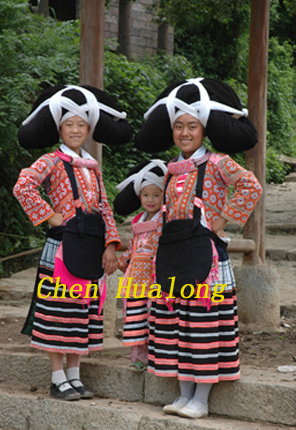 |
 |
 |
 |
Long Horned Miao of Guizhou
There lives a branch of Miao known as “Long Horned Miao” in the remote region between Liuzhi, Zhijin and Nayong whose women use a wooden horn and their own hair or their mothers’ hair together with black wool to decorate their heads. Currently there are only some 4,000 Long Horned Miao who mainly live in 12 villages at a high elevation amongst dense clouds and who seldom contact or communicate with any outsiders. The 12 villages are Upper Anzhuang, Lower Anzhuang, Longga, Bukong, Xiaobatian, Gaoxing in the Miao and Yi autonomous town of Suoga; Dawanxin, Xinfa in the town of Xinhua; Changdi, Guanzhai, Xiaoxin, Huadong and Yizhongdi in the town of A’gong. Their culture is well preserved and has been practised from generation to generation for several hundred years. Their traditions are very simple and charming: they have equal democratic rights, rich wedding, funeral and sacrificial rites, stylish music and dance, exquisite and gorgeous embroidery and they live by the tradition of ‘men ploughing and women weaving’. The first eco-museum in Asia was built in Longga village in 1998 to preserve the culture and tradition of the Long Horned Miao.
The 12 Long Horned Miao villages are in barren hill country at an elevation of between 1,400-2,200 metres above sea level within an area of 120 square kilometres. According to ancient oral legends and Han documents, we know that a few Miao came from Qianxi and Dafang counties and scattered to live in the jungle on the boundary between Zhijin and Langdai in the early Qing dynasty, some 300 years ago, hence Qingmiao. To survive after war they had to open up new clearings in the jungle. They used wooden horns for their head decoration to distinguish whether they were from the same or a different clan. They did not live as associated communities until the 20th Century but have now become the 12 villages. The region’s land is barren and dry so corn is the staple food and little rice is available.
 |
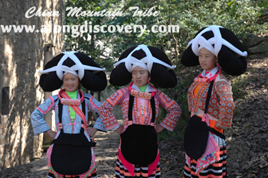 |
 |
The folk customs of the Long Horned Miao are characterised by rich cultural
connotation. The wedding and funeral ceremonies and Tiao Hua Po festival
are particularly special. Although the life style is very simple, the
wedding and funeral ceremonies are grand and complicated and their meanings
are mysterious.
The first lunar month is the season for the young to fall in love during a festival named Tiao Hua Po which is held on a different day in each of the 12 Long Horned Miao villages. The young people do not return home but continue to participate in the festival moving from village to village seeking a love partner. They are free to choose their sweet heart.
The wedding ceremony of the Long Horned Miao, however, is very complex with strict rules and traditons to be followed. The process is that a matchmaker (or go-between) is sent to the girl’s home to ask for permission for the marriage to take place. The girl’s parents, uncles, aunts and the village head will have discussions about whether or not the wedding will be permitted. If the wedding is agreed, a procession of the bridegroom’s relations visits the bride’s home to meet her relatives. Before entering her home they will be beaten by the girls from her village who block the way and beat the members of the procession with hemp straw. The matchmaker is the first person to be beaten and he will be beaten three consecutive times. After this it is then agreed that the members of the procession may enter the house. However, after entering the house, the matchmaker has to give many good speeches of greeting and offer three cups of rice or corn wine to the bride’s relatives (her
parents, uncle and aunts). Meanwhile, the bride’s relatives sing and scold the go-between (the matchmaker). They want him to guarantee that the marriage will be a happy one with good fortune. They will then allow the bride to go to the bridegroom’s home with a procession of her relatives. At the gate of the girl’s house, the matchmaker will again be beaten three times until he begs the girls to stop Eventually the girls finish beating him. This tradition has been practised for generations. The meaning of the custom is that the harder the beating the better the bride will be cared for by her new family and the wedding will have good fortune and last for ever.
 |
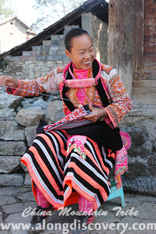 |
 |
 |
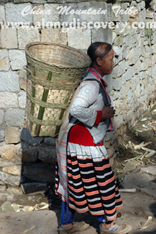 |
 |
 |
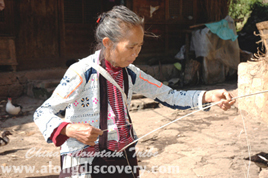 |
||
The Long Horned Miao funeral ceremony is also a very interesting and an important component of their spiritual culture. Every funeral ceremony is a time to communicate with their ancestors and to go over their own history and traditional culture. The Long Horned Miao funeral ceremony is a long and grand process. It is traditionally called Daga in the local dialect, meaning that the dead will become a spirit and go back to the former homeland of his forefathers. Rigorous procedures must be followed for the Daga. Someone must be die naturally, that is to say, he must die of old age. A death at a young age or by an accident cannot receive the ceremony of Daga. If the death was that of an old man, the Long Horned Miao from the 12 villages will participate in the funeral by giving gifts and singing songs of lamentation for the dead. The villagers initially come to protect the deceased’s soul during the night. The greater the number of people participating in the funeral the more this signifies a higher social status of the deceased. Suona, Lusheng (musical instruments) are played and songs are sung for the funeral. The Daga ceremonies last a day and a night until the corpse is carried to a grave on the hillside. The shaman plays an extremely important role and leads the ceremony. Three days later, the deceased’s family will invite the shaman to conduct a ceremony through which the deceased’s soul says good bye to family members and villagers and sets out on the ancient trail to the homeland of their ancestors. The whole process lasts 5-7 days during which a buffalo and goats are sacrificially killed. This signifies that the deceased will not be poor in the other world. The Long Horned Miao are shamanists as are my people, the Long Skirt Miao, believing that everything has a soul and thus worshiping trees, rocks and the like every year. (See Tony’s story of The Miao shaman's ceremony).
The Long Horned Miao women are skilled at embroidery and wax printing. The men’s front aprons are particularly finely stitched. Women draw freehand designs in wax to create batik without any fixed patterns and thus you do not find exactly same batik work, even made by the same person. Women’s long hair with black wool wrapped around the wooden horn is very special and has become the symbol of the Long horn Miao.
To be frank, from my point of view, I think the Long Horned Miao are very poor and I sympathise with them. Recently the government has started to pay considerable attention to them and some anti-poverty work has been done in Longga village. The villagers there received a certain degree of help but now the challenge of new problem has arisen. The villagers in Longga have become more and more commercial, leading to a few unhappy accidents causing tourists who dreamt of visiting the village being embarrassed and irritated. Therefore it is an urgent matter for the government, the villagers and all who aim to help the Long Horned Miao, to think seriously about the best way in which they can be helped to have a better life and to preserve their culture.
| To make the tour, contact Along | |
| All texts and image by Chen Hualong | Email: tony6868@163.com, alongdiscovery@hotmail.com |
| All rights reserved by Hu Yan | We-chat:13885136348 |
| @2008-2029 | 24 Hour Cell: 0086--13885136348 Tel&Fax:0086-851-86302559 |